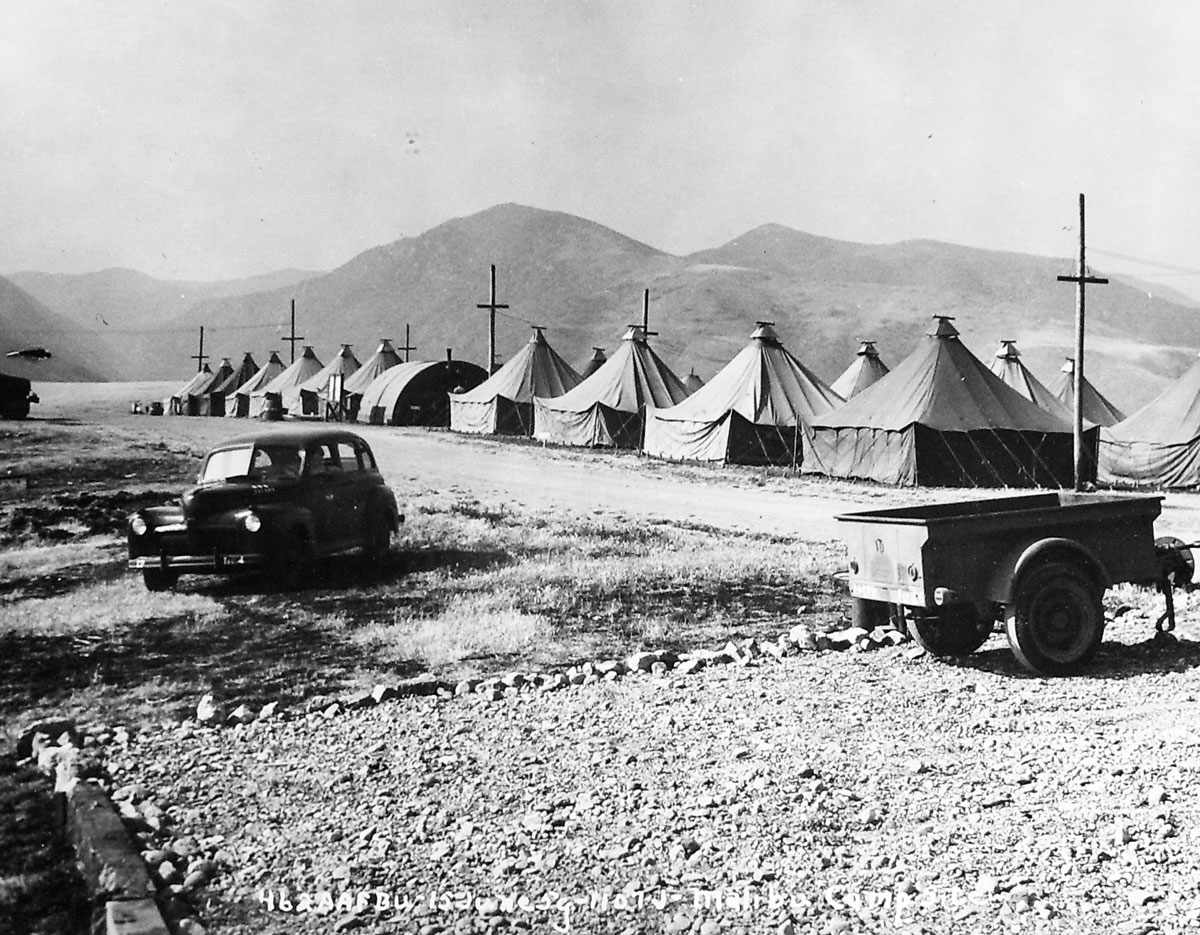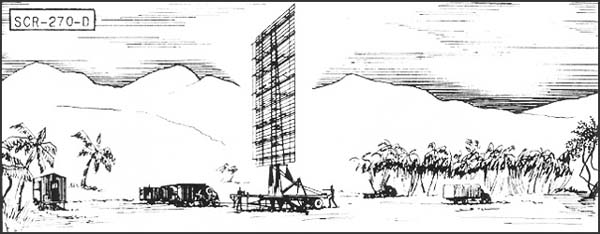
Captain Alfred L. Coffman, Captain Theodore R. Gwillim, and First Lieutenant Joseph M. Quinn arrived from the Aircraft Warning Unit Training Center, Drew Field for temporary duty at Western Signal Aviation Unit Training Center (WSAUTC) on 11 January 1945 to coordinate the selection of radar training sites in the Central Valley and on the Pacific coast. Laton, ten miles north of Hanford, CalIfornia, was chosen as the Valley site because of its excellent radar techniCal features. On 14 February 1945 the footing forms were poured for inallation of an SCR 615-A (height finding radar set) .. Two days later equipment installation was begun on two other sites at Laton for radar sets SP-1M, AN/TPS-1 and SCR-270. Laton was obtained as a camp site for WSAUTC by clearance lease.
On 12 March 1945 First Lieutenant M., B. Luke, ground reporting equipment advisor to the Director of Operations, accompanied the Deputy Base Commander and the Supervisor of the Tactical Unit Training Department (TUTD) on a trip to Visalia, California, to determine the training facilities available there. It was decided that these facilities were superior to those at Laton, which lacked living oonveniences, and therefor the training sites at Laton were moved to Visalia. Visalia had been used previously by WSAUTC. Facilities were made available for radar training at this sub-base of Hammer Field.
The coastal site selected for the individual replacement training (IRT) and cadre training program was at Malibu, approximately ten miles east of Santa Monica. This site was a fixed radar installation (Radar Site B-36) of the Los Angeles Control Group, but during the first five months of 1945 WSAUTC training facilities grew to such an extent that they overshadowed the Los Angeles Control Group.
In the new air warning training program it was necessary to provide an organization to contaln the overhead personnel necessary to train and administer those aircraft warning detachments and individual replacement trainees who underwent final phases of operational training at Visalia and Malibu Beach. Flight B of Squadron T-2, 462nd Army Air Forces Base Unit (AAFBU), was formed and placed under the command of Captain John F. Meskiel formerly f'ield coordinator.. Flight B was composed of two detachments of about 65 men each, and further divided into training sites under the direction of TUTD:
Detachment No.1:
- Visalia Army Air Field - Captain Maris L Ward, Commanding, Sites 1,2,3, and 4, each with one SCR-615, AN/TPS-1, AN/CPS-5, SP-1M .
Detachment No.2:
- Malibu Beach - Captain Dale E Repp, Commanding, Sites 5,6, and 7 with two SP-1Ms and one AN/TPS-1.
After the required course was completed at Detachment No. 1, following ground individual training, the trainees were sent to Detachment No. 2 for the final phase operationnl training, prior to overseas shipment.
Change in Organization
Camp Malibu, operated by the WSAUTC at Malibu Beach, California, remained in operation during the three-months' period from 1 June 1945 through 2 September 1945.. However, a change in organization occurred on 21 June 1945 when Squadron G, 462nd AAFBU. Camp Pineciale, was activated to handle the training program at Camp Malibu. Prior to the activation of Squadron G, Detachment 2, Flight B, Squadron T-2, 462nd AAFBU had been in charge of the training program at Camp Malibu. Inasmuch as all per sonnel, both trainee and overhead were already present for duty and the prescribed training were in progress, the change in organization affected only the orderly room, and was made to facilitate the handling of administrative and personnel problems of the trainees. The activation of Squadron G meant that most problems, of an administrative and personnel nature, could be solved at Camp Malibu instead of being referred back to the parent organization at Camp Pinedale.
G Squadron was aasigned to the Troop Commander but was under the supervision of WSAUTC TUTD for training purposes.
The strength of the squadron consisted of one officer and sixty-three enlisted men on 30 June 1945; one officer and seventy-four enlisted men on 31 July 1945; and one officer and seventy-one enlisted men on 31 August 1945.
Relationships with WSAUTC Staff Sections
Responsibility for the proper accomplishment of Squadron G's mission and the training of personnel was to the Commanding Officer WSAUTC, through the WSAUTC Executive Officer.
Tactical and operational supervision carne through the supervisor of the Team and Unit Training Division (TUTD) of WSAUTC, rooster training plans, operational directives, and the control of technical equipment, under the supervision of the TUTD. The latter agency also controlled the movement of trainee personnel and acted as a coordinating section in the movement of overhead personnel.
The original supply of communications, radar and equipment, was obtained through the Director of Maintenance and Supply, WSAUTC. Special items necessary to the performance of the tactical missions were also supplied to Squadron G buy the office of the Director of Supply, WSATUTC.
The supervision of the use of forms and publications, records of overhead personnel, and legal service, came through the office of the Director of Administration, WSAUTC.
Personnel
A new marming table for Squadron G was authorized on 18 July 1945. Authority for the allotment of personnel to Camp Malibu was contained in a letter from Colonel W. H. MacDonald, Commanding Officer of the WSAUTC, to the Commanding Officer, Camp Malibu. Personnel thus allotted consisted of eleven officers and seventy enlisted men, and included an additional automobile equipment mechanic, as requested by Squadron G.
Training
During the period from 1 June through 2 September 1945, training was carried on at Camp Malibu in the following radar sets:
1. AN/CPS-1 microwave, early warning, long range, search radar set.
2. AN/CPS-4 ultra high frequency, height finding radar set.
3. AN/CPB-5 ultra high frequency, long range, search radar set.
4. AN/TPS-1B ultra high frequency, portable, light warning, medium range, search, radar set.
5. AN/TPS-10 mircrowave, portable, height finding, medium range, radar set
range, radar set.
6. SCR-615, T-l and B models, microwave, ground control interception, height finding, medium range, radar set.
7. SP-1M microwave, ground control inerception. height finding, medium range radar set.
Five sites at Camp Malibu were used at various times by Squadron G for purposes of instruction. From time to time radar set teams were moved from one site to another, except where there were fixed installations.
During August 1945 training dropped from normal activity on seven radar sets to operation of only one, the AN,/CPS-5. Individual replacement training on radio equipment:; continued as usual, however, which was the status of the base as of 2 September 1945.
Lastly, there was a target range at Point Dume, operated by the 37th AAA Brigade, US Army. This was termed the Point Dume Firing Point. A few references were found confirming this, and that 37mm automatic weapons were fired at this site. No description was found of what facilities, if any, were built there. It is assumed, although not expressly documented, that the 37th AAA Brigade rotated units to the firing point for training. Whether buildings were erected or troops were quartered in tents is not stated. No reference to weapons larger than 37mm was found.

| Altitude, feet | 1000 | 5000 | 20,000 | 25,000 |
| Range, miles | 20 | 50 | 100 | 110 |